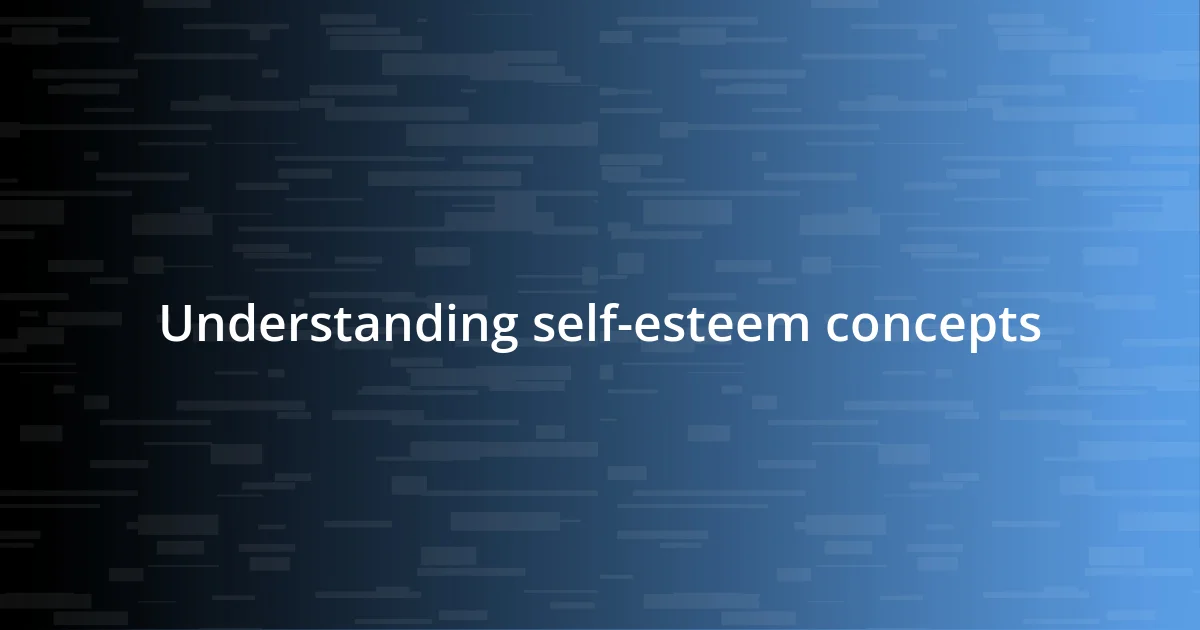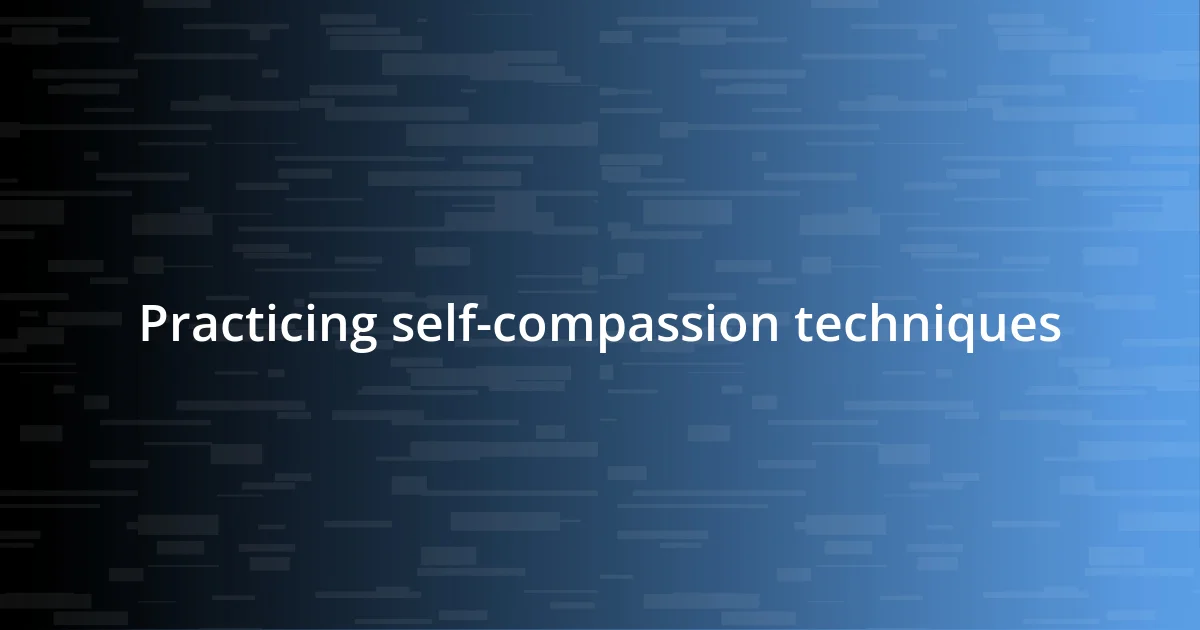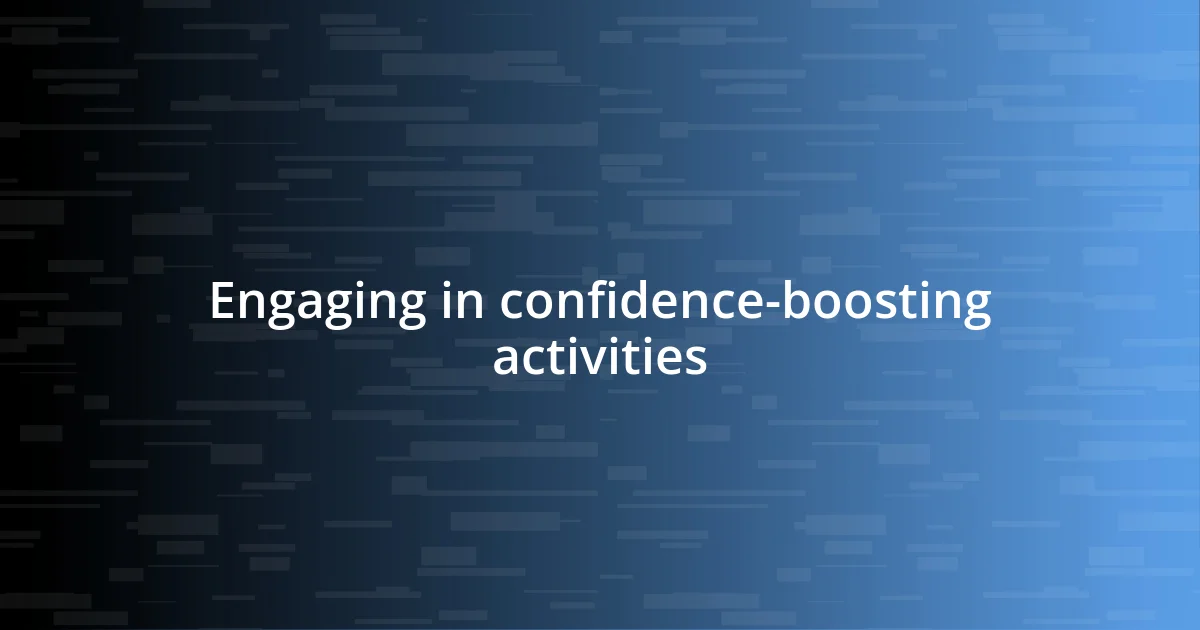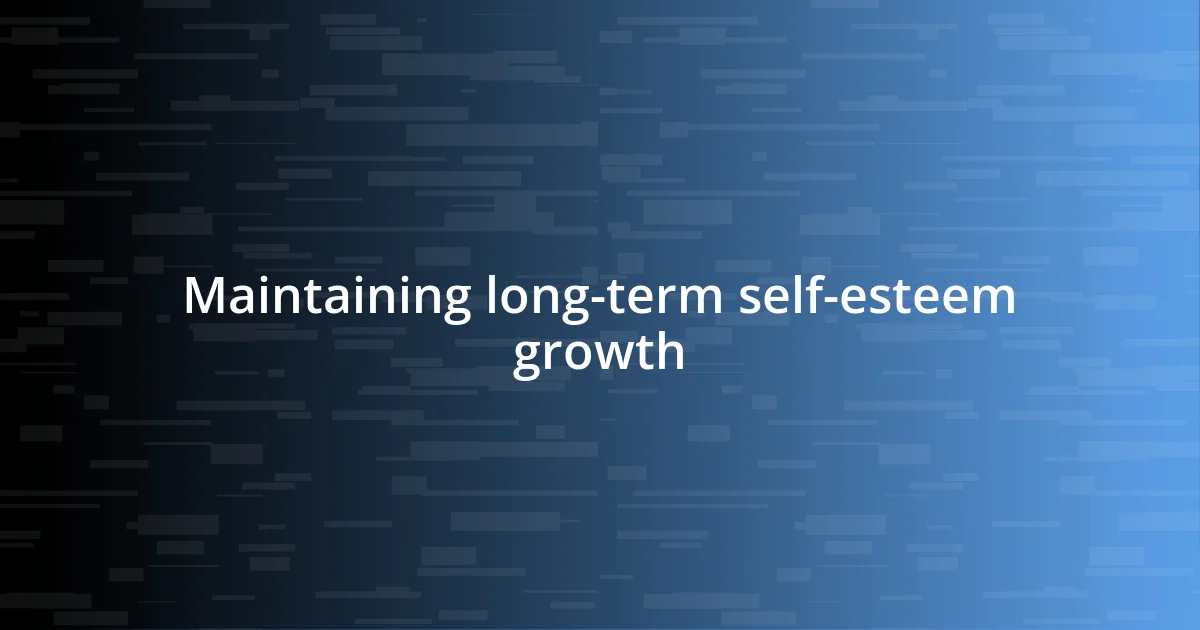Key takeaways:
- Understanding the distinction between self-esteem and self-worth fosters personal growth and challenges negative self-talk.
- Recognizing and addressing negative thought patterns helps reshape self-perception and build a healthier self-image.
- Engaging in confidence-boosting activities and maintaining supportive relationships are crucial for long-term self-esteem growth.

Understanding self-esteem concepts
Self-esteem is more than just a buzzword; it’s a crucial aspect of our emotional well-being. I remember when my own self-esteem was at a low point. I constantly questioned my worth, asking myself, “Why can’t I just believe in myself?” This reflection made me realize that self-esteem is often shaped by our experiences and the messages we receive from those around us.
One vital concept to grasp is the difference between self-esteem and self-worth. While self-esteem reflects how we see ourselves, self-worth underpins our belief in deserving respect and happiness, regardless of external validation. I’ve found that understanding this distinction helped me challenge negative self-talk. Have you ever caught yourself thinking you’re not good enough? Recognizing that our intrinsic value is independent of our achievements was revolutionary for me.
It’s also worth noting that self-esteem isn’t static; it can ebb and flow based on our circumstances and mindset. For instance, I noticed that when I surrounded myself with supportive friends, my confidence soared. This led me to ask, “Who in my life uplifts me?” By consciously cultivating positive relationships, I began to rebuild a healthier sense of self, one step at a time.

Recognizing negative thought patterns
Recognizing negative thought patterns is the first step towards rebuilding self-esteem. I vividly remember the moments when my inner critic would drown out any positive affirmation. I’d find myself thinking, “I’m always making mistakes” or “I’ll never succeed.” These repetitive thoughts clouded my judgment and made me feel trapped in a cycle of negativity.
To better identify these patterns, here are some common negative thoughts to watch for:
– All-or-nothing thinking (seeing things in black and white)
– Overgeneralization (making broad conclusions based on a single event)
– Catastrophizing (expecting the worst possible outcome)
– Personalization (blaming yourself for things outside your control)
– Filtering (focusing only on the negative aspects of a situation)
Each time I caught myself falling into one of these traps, I felt an urge to dig deeper. I learned that acknowledging these thoughts didn’t make them true; it merely created an opportunity to question and challenge them. Over time, and with practice, I discovered that simply recognizing these patterns helped me reclaim my narrative, easing the grip they had on my self-image.

Setting achievable self-esteem goals
Setting achievable self-esteem goals is a pivotal step in my journey towards a healthier self-image. I remember setting small, specific goals like sharing my thoughts in a group discussion or complimenting myself in front of the mirror. Each accomplishment, no matter how small, felt like a triumphant cheer in my mind, reinforcing my belief that I was worthy of respect and love.
I realized that focusing on measurable and realistic goals made my progress tangible. For instance, rather than telling myself I would “just feel better,” I aimed to write down three things I appreciated about myself each day. This practice created a tangible method to track my growth, and the more I acknowledged my strengths, the more my confidence began to bloom.
Breaking down my larger aspirations into bite-sized, achievable tasks helped maintain my momentum. I learned to celebrate each mini-victory, which transformed my self-perception rather than relying solely on grand goals. I often reflected, “What small step can I take today that will lead me closer to feeling better about myself?” This simple question kept me grounded and motivated.
| Goal Type | Example |
|---|---|
| Self-Reflection | Write down three positive traits daily |
| Social Engagement | Participate in one group discussion per week |
| Self-Compassion | Compliment myself in the mirror each morning |

Practicing self-compassion techniques
Practicing self-compassion techniques transformed my relationship with myself. One of my first steps was to speak to myself like I would to a friend. For instance, when I faced setbacks, I would sometimes remind myself, “It’s okay; everyone makes mistakes.” It felt strange at first, but gradually, the warmth of self-kindness penetrated my self-critical thoughts, softening the harshness I had learned to accept.
I remember a particularly tough day when my inner dialogue was relentless. Instead of succumbing to the negativity, I decided to embrace a self-compassion exercise called “the self-compassion break.” I paused, placed my hand over my heart, and acknowledged the discomfort I felt. By simply recognizing my suffering as part of the human experience, I began to feel a weight lift off my shoulders. This moment taught me that acknowledging my feelings was not a sign of weakness, but an essential step toward healing.
Reflecting on those techniques, I often ask myself: “How would I treat a loved one facing similar struggles?” This question became a powerful reminder to be gentle with myself. Embracing self-compassion allowed me to nurture my inner dialogue and build resilience. By treating myself with kindness, I realized I was cultivating an essential part of my journey to rebuild self-esteem.

Building a supportive social network
Building a supportive social network was a game changer for me as I worked on my self-esteem. I realized that surrounding myself with individuals who uplift and encourage me created a safe space where my growth could thrive. It was like having a cheerleading squad that celebrated not only my achievements but also my journey, no matter how small. Have you ever felt the difference when you’re around positive people? I certainly did, and it sparked a sense of belonging I hadn’t experienced in a long time.
One memorable moment stands out: I joined a local book club, hoping to meet others who shared similar interests. As I participated in discussions, I found myself opening up more and sharing my opinions confidently. Each supportive comment from fellow members felt like a step toward my newfound self-worth. In those discussions, I felt valued, and this affirmation was pivotal. It made me think, isn’t it incredible how the words of others can help shape our self-perception?
Also, I learned to be intentional about the relationships I nurtured. I let go of connections that drained my energy and sought out friendships that brought joy and positivity. Recognizing that I deserved to be treated with respect was empowering. Have you ever evaluated your social circle? It’s enlightening! Building a supportive social network wasn’t just about numbers; it was about quality connections that reinforced my worth and encouraged my personal growth.

Engaging in confidence-boosting activities
Engaging in confidence-boosting activities became a cornerstone of my journey to reclaiming my self-esteem. I remember taking up dance classes, even though I had two left feet. At first, I felt clumsy, but as I practiced and improved, every small victory added a sprinkle of confidence. Has there ever been a moment when a new skill made you feel more capable? For me, learning to dance wasn’t just about the steps; it was about celebrating progress and embracing the joy of movement.
One day, after particularly challenging sessions, I would often leave the studio feeling light and empowered. It was fascinating to realize how physical activity opened my mind to self-acceptance. Just think about how invigorating it is to achieve something that once felt impossible! I found that activities like hiking, painting, or even cooking brought out my creativity and reminded me of my capabilities. Each experience served as a reminder that stepping out of my comfort zone could lead to profound personal growth.
I also discovered the importance of setting achievable goals within these activities. For instance, I would challenge myself to learn a new song or paint a piece in a week. The thrill of accomplishing these tasks bolstered my self-worth significantly. Have you ever set a small goal and felt a rush upon achieving it? I realized that confidence isn’t born overnight; it flourishes through consistent practice and celebrating tiny milestones. Engaging in confidence-boosting activities transformed my self-perception, showing me that my worth is not defined by perfection but by the courage to try.

Maintaining long-term self-esteem growth
Maintaining long-term self-esteem growth can sometimes feel like walking a tightrope, balancing progress with the everyday challenges life throws our way. For me, one key practice has been self-reflection. I set aside time each week to jot down my thoughts and feelings, celebrating the wins and digging deep into any setbacks. This routine helps me clarify my emotions and reminds me that growth isn’t always linear. Have you ever noticed how understanding your feelings can alter your perspective on seemingly negative experiences?
Moreover, I’ve realized the pivotal role of continuous learning in sustaining my self-esteem. Whether it’s exploring a new hobby or reading self-help books, immersing myself in learning keeps my mind engaged and fosters a sense of accomplishment. One of my favorite moments involved picking up photography. Every new technique or shot I mastered reinforced my belief in my creative abilities. It made me think—how often do we underestimate the power of learning in shaping our self-worth?
Finally, I recognized that self-care is non-negotiable in this journey. I began incorporating small acts of kindness toward myself, like treating myself to a quiet afternoon or indulging in a favorite treat. These seemingly simple gestures cultivate a nurturing environment for my self-esteem to flourish. Have you ever paused to give yourself some well-deserved love? Embracing self-care has instilled in me the understanding that I deserve happiness and respect, which lays a strong foundation for long-term growth.














